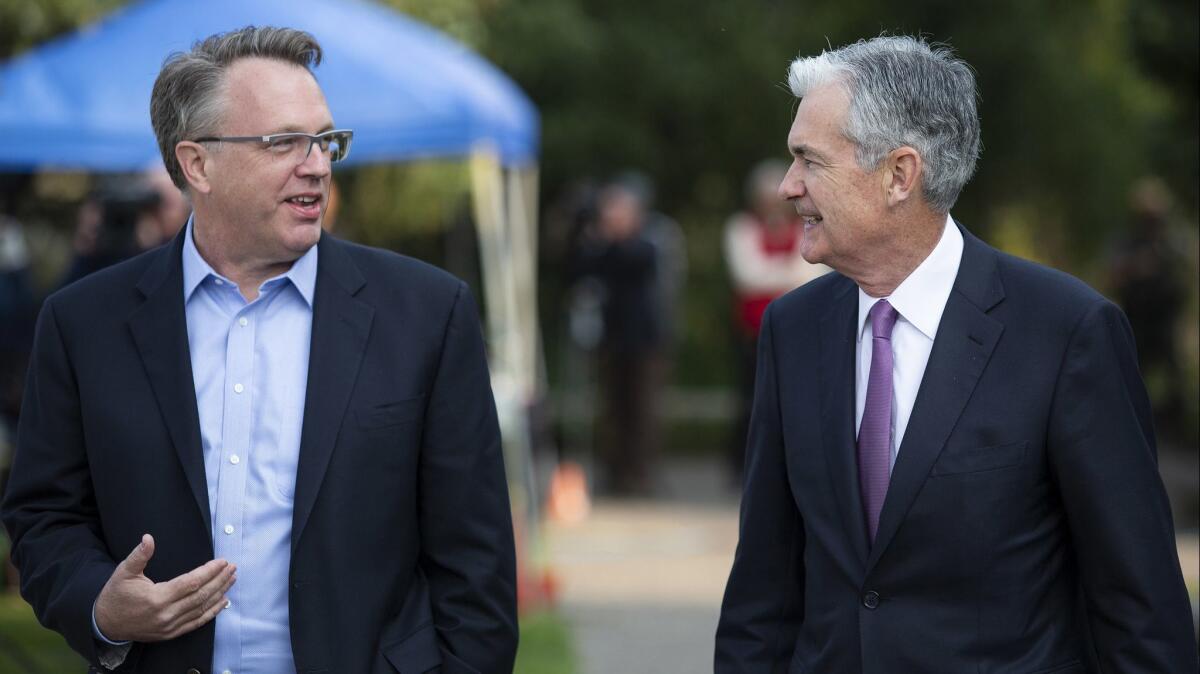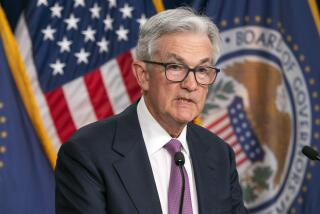Fed official says he supports further rate hikes despite market reaction to Powell

- Share via
Federal Reserve Bank of New York President John Williams gave an optimistic review of the U.S. economy, reiterated his support for further gradual interest rate increases and expressed no concern that investors have dialed back expectations for policy tightening in 2019.
Markets moved sharply after Fed Chairman Jerome H. Powell said last week that the Fed is getting closer to its range of estimates for the neutral interest rate — the dividing line between tight and easy policy — and his phrasing was widely interpreted as a dovish signal.
Interest rate futures pricing has adjusted so that they’re now anticipating just one rate increase in 2019 following a hike at the Fed meeting later this month. That’s at odds with the Fed’s Summary of Economic Projections from September, which suggests that officials see a rate increase this month and three more hikes next year. That forecast will be updated when officials gather Dec. 18 and 19 in Washington.
“My own view is — I think completely consistent with what Chairman Powell said — is that the U.S. economy is strong, but there are definitely” some “risks on the horizon,” Williams said Tuesday in a news briefing. The Fed is in a good position to react to whatever the economy does going forward, said Williams, a standing member of the Federal Open Market Committee, which sets the federal funds target rate.
“There’s a good — like 50% chance — that the economy performs faster, inflation picks up a little bit more than we expect, and I think we’re positioned to adjust to that,” Williams said. “We’re well-positioned to adjust our path of interest rates if the economic data disappoint.”
Despite that nod to uncertainty, Williams painted an overwhelmingly positive picture of a strong economy that’s achieving the Fed’s goal of full employment. He said he expects tailwinds from fiscal stimulus to persist into 2019, and he thinks inflation will move slightly — but not not dramatically — above the Fed’s 2% target.
“I expect with the economy continuing to grow nicely above-trend, we’ll see further job gains, further declines in the unemployment rate, and unemployment will edge slightly below 3.5% over the next year or so,” he said. “I do continue to expect that further gradual increases in interest rates will best foster a sustained economic expansion and sustained achievement of our dual mandate goals.”
As the economy improves, the Fed will need to reconsider how much guidance it’s providing, Williams said. The central bank will get to a situation “where it’s not as obvious that we are going to be raising interest rates at a gradual pace over time,” he explained.
“Then it will be appropriate to further step back on how much explicit forward guidance we give in statements,” he said, though he said the dot plot and press conferences will continue to provide a “transparent and comprehensive view” of the Fed’s outlook.
One “open question” is how low unemployment can remain without stoking hotter inflation, the New York Fed chief said. Unemployment is at 3.7%, well under the 4.5% that Fed officials have penciled in as the long-run sustainable rate.
“Right now I think we’re in a great position,” Williams said. “We’re in a good position to allow the unemployment rate to be below 4% for the next few years without really having — I don’t have much concern about inflation pressures picking up.”
Against that backdrop, he suggested it’s OK to continue testing the limits. “Over the next couple of years we’re going to continue to learn whether maybe a lower unemployment rate is sustainable without creating inflationary pressures,” he said.
The Dow Jones industrial average was down in midday trading more than 600 points following Williams’ speech but many market analysts have attributed the fall to disappointment about the significance of a truce in the China trade war announced over the weekend by President Trump.
Smialek writes for Bloomberg.
More to Read
Inside the business of entertainment
The Wide Shot brings you news, analysis and insights on everything from streaming wars to production — and what it all means for the future.
You may occasionally receive promotional content from the Los Angeles Times.










